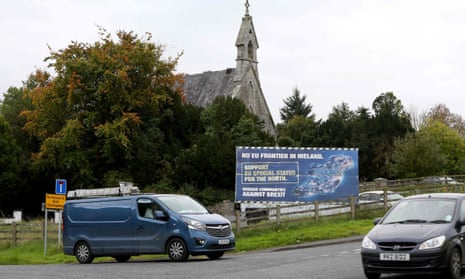Once more commonly heard in talk about baseball than politics, the backstop has become one of the most discussed and contentious elements of the Brexit negotiations. It is a simple basic principle, but no one is able to agree precisely how it will work.
What is the Brexit backstop?
Variously described as an insurance policy or safety net, the backstop is a device intended to ensure there will not be a hard border between Northern Ireland and the Republic of Ireland, even if no formal deal can be reached on trade and security arrangements.
It would mean that if there were no workable agreement on such matters, Northern Ireland would stay in the customs union and much of the single market, guaranteeing a friction-free border with the Republic. This would keep commitments of the Good Friday agreement intact.
Both the UK and EU signed up to the basic idea in December 2017 as part of the initial Brexit deal, and it was formalised in the legal text of the withdrawal agreement, but there have been disagreements since on how it would work.
The DUP has objected to it, as it potentially treats Northern Ireland differently from the rest of the UK, creating a customs divide in the Irish Sea, which is anathema to the unionist party.
Hardline Tory Eurosceptics also object to it, as they perceive it to be a trap that could potentially lock the UK into the EU’s customs union permanently if the UK and EU cannot seal a free trade agreement. That would prevent the UK from doing its own free trade deals with nations outside the bloc.
What was added to May’s withdrawal agreement?
In January 2019, the “joint interpretative instrument” – a legal add-on to the withdrawal agreement – was given to Theresa May to try to help her to get her deal through the UK parliament. It gives legal force to a letter from Jean-Claude Juncker and Donald Tusk, then presidents of the commission and council. This letter stated the EU’s intention to negotiate an alternative to the backstop so it would not be triggered, or, if it was triggered, to get out of it as quickly as possible.
In addition, a unilateral statement from the UK set out the British position that, if the backstop was to become permanent and talks on an alternative were going nowhere, the UK believed it would be able to exit the arrangement.
Additional language was added to the political declaration that emphasised the urgency felt on both sides to negotiate an alternative to the backstop, and to flesh out what a technological fix would look like. However, it failed to persuade the attorney general, Geoffrey Cox, who said that while it ‘reduces the risk’ of the UK being trapped in a backstop indefinitely, it does not remove it.
Theresa May could still not get parliament to approve her deal.
What happens next?
During their campaigns to become prime minister, both Conservative party leadership contenders, Boris Johnson and Jeremy Hunt, appear to have declared the Northern Ireland backstop “dead”, and promised to throw it out of any deal they negotiate with the EU. The EU has repeatedly stated that it will not reopen the withdrawal agreement for renegotiation.
